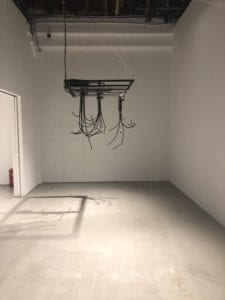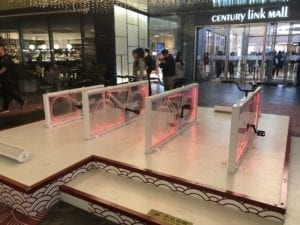A.
When I was finally able to visit the Chronus exhibit, I was overwhelmed with the amount that the artists did with such little material. In class sometimes I feel limited because of the small motors and Arduino boards we work with. And during the mid-term project I had absolutely no idea what to try and accomplish. Even though the goals were clearly laid out for us, my partner and I still had a difficult time coming up with a concept owing to the small materials we had on hand. I really enjoyed watching the Autonomous System, which was the large house like device propped up with wooden stilts (Ralf Baecker). Within the house, there was a large base like structure attaching strings which extended out onto the outer shell of the house. Also attached to these strings were small weights. It worked like a pulley system where the weights would be raised and lowered within certain intervals programmed into the servo motors. It was amazing to me to see how much can be done with so little available to the artists. Projects like these serve as a great inspiration for my future work in interaction lab and beyond. Compared to a normal art exhibit, I found a few differences that were less than subtle. When I step into a traditional art gallery, I am typically looking at the walls where the paintings are hung. But in the Chronus exhibition, the art was all around and in-between us. The first project, Artificial Intuition, is all around you as you walk into the exhibition (Zhang Hua). The sensors are above and beside you so that the hands of the project can move and block you as you try and enter the exhibition. To me, this is the coolest aspect of interactive art exhibitions. So many famous museums around the world are centered around having their artwork displayed on a wall to maintain the look and feel of tradition. Or if it is displayed in the middle of the room, like a sculpture for example, it is on a pedestal or a stand. In the Chronus exhibition, the art is all around you. It makes for an interactive and engaging experience that I enjoy far more than a traditional art museum. Some pictures from the Chronus exhibition can be viewed below.

“Artificial Intuition”

“Autonomous System”
B.
In the first interactive project I researched, musical bikes, subjects ride four stationary bikes which then trigger a song to play on the loudspeakers connected. Each bike is connected to one part of the song. For example, the far left bike only plays the beat, while the far right bike plays the vocals. The bikes do so not matter how fast the subject rides, as long as they are peddling. So, when four people are riding the bikes at the same time, the entire song is played at full speed through the loud speaker. If one person stops, the other ¾ of the song continues playing without a part (for example, the voice of the singer). Below is a picture of the project next to century avenue metro stop.

“Musical Bikes”
I think this is a successful interactive project because it incorporates a user relationship with the machine. By user relationship, I mean that when the subject uses the machine, the machine reacts and then triggers a song. Going back to my original definition, “Interaction is a continuous conversation between two or more corresponding elements.” This fits along with the bike and song concept because as the subject rides the bike, part of the song plays. The machine reacts to the user riding the bike, thus constituting a conversation between the corresponding elements.
A separate interactive project I researched was Scott Clandinin’s “Interactive Mario Mushroom Block.” In this, there is a box similar to a Mario mystery box attached to a wall on a vertical shaft. When the subject hits the bottom of the box, the box jumps up and opens its roof. A mushroom comes out of the roof, just as it would in the Mario video game. I found this to be a successful version of interaction because it is a conversation between the human hitting the box and the mushroom popping out as a result. It is a textbook conversation between between two corresponding elements. I also liked how it played off of a contemporary video game rather than only have the base mechanics with no design. As I’ve researched many projects, I’ve found design to be critical in attracting users. The same goes for the musical bikes. I first found out about it was I was 500 yards away and the music drew me closer.
A project that I think is less successful, but still within the realm of interaction is “Expanded ID” by Anaisa Franco. Expanded ID is essentially a bench with a fingerprint scanner attached to it. In Franco’s words “Expanded ID is a parametric interactive public art installation that scans the visitor finger print and transforms its unique shape in a generative animation, which pulses colorful 3D blocks of the user’s unique finger prints shapes.” (Anaisa Franco) Once the reader is done scanning the fingerprint, it projects the fingerprint in front of the bench. It does so in an array of colors and designs, illustrating the beauty and uniqueness of a finger print. Although this is technically interaction, is is not necessarily a conversation between two elements. In simple, the bench is just projecting out the subject’s fingerprint. There is not much more to it. While it is an interesting concept for an art installation, I don’t think it encapsulates all of the necessary qualities of interaction.
C.
“Interaction is a continuous conversation between two or more corresponding elements.” I think the base of this definition has held true throughout my learning, but the qualities of a good interactive project do not necessarily have to include a continuous element to it. Continuous to me would mean the project is constantly on while the user is using it. Take the rain room for example. The person is walking around and the sensors are using this data to turn off the water wherever the subject walks. This is a continuous project. Most projects I see don’t contain this continuous element to them but are still interactive. I think for it to be a sound project, it has to be a reactionary relationship between two or more elements involved. Just as Chris Crawford argues, interaction is a “cyclic process in which two actors alternatively listen, think, and speak” (Crawford 5). For me, this element of a conversation is essential in interaction. When one person speaks, the other responds. This is how people converse. So in a project, when a subject walks for example, the motion sensors sees that and react accordingly. Interaction is reactionary in the sense that the project senses the user and reacts based on the different inputs. The output depends on the type of input received by the project. The biking interactive exhibition in point B contains a correspondence between two or more parties involved. One person can ride the bike and create a fourth of the song, but in order for it to be successful, all four people need to be riding the bikes. To make this interaction work, people are engaged with the project and enjoying the end result. I think this relates to the overall theme of interaction where people want to enjoy and end result. The interaction needs to be something useful to the world, interesting, fun or anything else. On a deeper level, the bike project encourages exercise with fun music as the motivation. Expanded ID creates something cool, but not exactly useful to the world. The overall concept is abstract to the basic necessity of people. As I define it now, and for the purpose of my final project, interaction is a reactionary relationship/conversation between two or more corresponding elements. To make an interactive project work, it needs to be a conversation wherein the project reacts to the subject. Whether is is programmed to react a certain way or not, it still needs to sense that the subject or element is present in order to begin. A conversation always starts with one element or person and in this case, needs to have a result from the machine.
Works Cited
http://www.anaisafranco.com/expanded-id
Ralf Baecker, Autonomous System (Chronus Art Exhibition)
Zhang Hua, Artificial Intuition (Chronus Exhibition)
https://www.lacma.org/art/exhibition/rain-room (rain room)
https://dix2.com/#&gid=1&pid=10 (Musical Bikes)
Crawford, Chris. The Art of Interactive Design: A Euphonious and Illuminating
Guide to Building Successful Software. San Francisco, No Starch Press, 2003